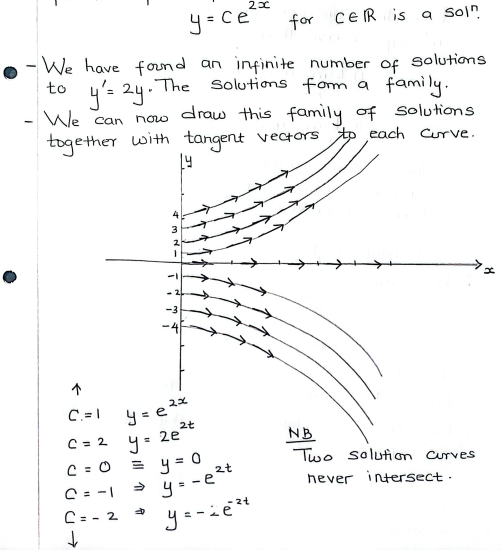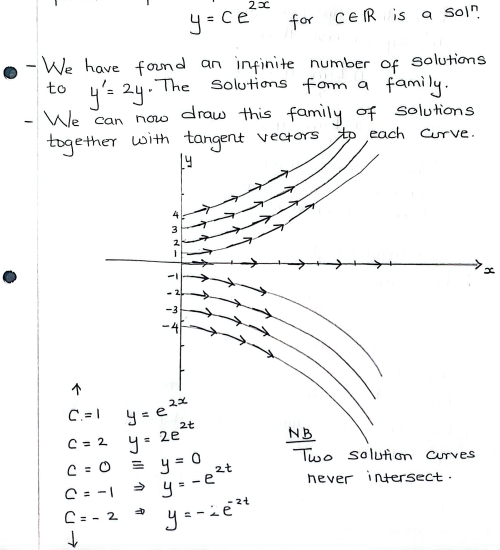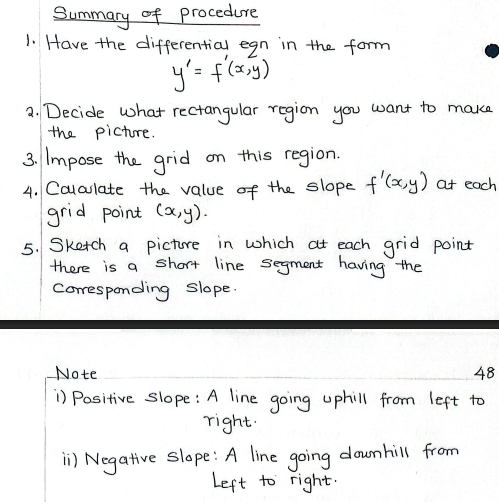Directional Fields, Euler's Methods, Applications of Diff Eqns
1/20
There's no tags or description
Looks like no tags are added yet.
Name | Mastery | Learn | Test | Matching | Spaced |
|---|
No study sessions yet.
21 Terms
for every differential eqn, there is a
infinite amount of “solns” to the differential eqn
therefore, there is generally a FAMILY of solns that have a general form
ex: f’(x) = 2*f(x) or y’ = 2y, the soln can be any soln of the form y = ce^(2x) for every c that’s a real num
directional field for the differential eqn y’ = 2*y (example)
two solns of a diff eqn NEVER INTERSECT
observe that the lim of y(x) as x → infy = infy IF y(0) > 0 (all the solns above the x-axis)
and the lim of y(x) as x → infy = -infy IF y(0) < 0 (all the solns below the x-axis)
each soln has their own unique initial condition of y(0)

directional field
a graph of some solutions of the given diff eqn
using arrows, draw the soln curves that start from their own unique initial condition y(0) (x = 0, y(0))
equilibrium soln
in the example in the image (y’ = 2y), the soln y(x) = 0 because the fn is a constant value (yields a horizontal line)

procedure of drawing a directional field

euler’s method concept
a numerical method for finding explicit/implicit solns that works for almost all diff eqns
uses the tangent at certain pts and you keep shifting the x-val until you find the estimated path of the soln/you can approximate the output value from the soln fn at some given x-pt
formulas for euler’s method
x0 = “prev” x-val or start x-val
y0 = “prev” y-val or start y-val
x1 = “next/current” x-val
y1 = “next/current” y-val
h = the “small step”, constant val, usually given to you, the amount the x-val is “shifted” each step
f(x0, y0) = the tangent/slope at the “prev” coord (x0, y0)
**f(x,y) = dy/dx

method for euler’s method
the goal is that when you are given a diff eqn (y’), you must approximate y(x) for some given x pt

exponential growth basics
a fn that maps out how quantities grow or decay at a rate proportional to their size
a quantity y that grows/decays at a rate proportional to its size fits w the eqn of the form:
dy/dx = ky (the RATE = constant * quantity, where quantity abides by its own growth/decay eqn)
exponential growth: dy/dx = ky, if k < 0:
eqn is called the LAW OF NATURAL DECAY
exponential growth: dy/dx = ky, if k > 0:
the eqn is called the LAW OF NATURAL GROWTH
exponential growth: dy/dx = ky, general form of the solution:
y = ce^(kx) for some c that’s a real num
exponential growth: population growth eqn model
dP/dt = kP and P(t) = P(0)*e^(kt) where P(0) is some initial population at some initial time
exponential growth: radioactive decay model
m(t) = m(0)*e^(k*t)
m(t) = mass of the substance at time t
m(0) = mass at t = 0
k = rate of decay
half life of a substance
the amount of time required for HALF of the mass of the quantity to decay
newton’s cooling law
rate of cooking of an obj is proportional to the temp diff between the OBJ and its SURROUNDINGS provided the temperature diff isn’t super significant
newton’s cooling law: formulas
dT/dt = k(T - Ts)
dT/dt = ky for y = T - Ts
T = temp of object
Ts = temp of surroundings
t = time
k = rate of cooling
newton’s cooling law: formulas cont’d
T(t) = temp of the obj after t minutes
y = T - Ts
y(0) = T(0) - Ts (Ts is a constant val)
and y(t) = y(0)*e^(kt) = k(T(0) - Ts)
y(t) = T(t) - Ts
continuously compounded interest: formulas
A = A(0)*(1 + r/n)^(nt)
A(0) = initial amount of money invested
r = interest rate
t = number of years
n = the amount of times the interest rate is compounded per year
continuously compounded interest: formulas 2
A = A(0)*(1 + r/n)^(nt)
r/n = in each compounding period, the rate is r/n
nt = compounding periods in t years
continuously compounded interest: formulas 3 (the most important)
A(t) = A(0)*e^(rt)
therefore, dA/dt = rA(0)e^(rt) = r*A(t) (which is the above line)